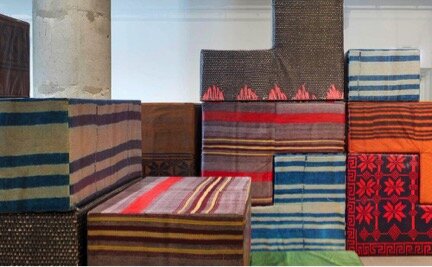Interview: Andreas Angelidakis
by Anna Kovler
Fev, 2020
Although Andreas Angelidakis trained as an architect, his art practice routinely attempts to decenter the architect’s role in building by giving his audience the task of constructing. His trademark lightweight foam blocks have filled the cavernous interiors of various museums, where visitors are allowed, and expected to pick up the large toy-like blocks and move them into whatever configuration suits their immediate needs. These pieces have served as tables for DJ equipment, seats for discussions, surfaces for drinking and eating, and even tagging. Taking inspiration from unorthodox, provisional, and “poor” architectural practices, Angelidakis interrogates the hierarchy built into the institution of professional architecture.
I spoke with Andreas on the occasion of the presentation of DEMOS: A Reconstruction at Arsenal Contemporary Art Montreal to find out how the piece was made and what he’s working on next.
Anna Kovler: What are the patterns that appear on the blocks of DEMOS: A Reconstruction?
Andreas Angelidakis: The patterns that you see are carpets I bought at the Athens flea markets, and they became digitized and used as textures. The piece got its name because it’s actually a reconstruction of a piece I did for the Berlin biennial in 2014. This was a room with blocks covered in Greek carpets, and a precursor to the pieces I made for documenta, and MOCA, but it was not movable. So I photographed all the carpets I had in that piece and selected about 15 and used them as textures for these blocks.
AK: How do you choose the scale and dimensions of the blocks?
AA: The system references the steps on the Acropolis, so the size more or less comes from that, but I’m also thinking about what’s comfortable for two people to sit on, and making sure there is space for the feet of the person behind them. It’s part Acropolis, and part bleacher seating. All the blocks are proportioned to work with each other, so one piece that is oblong orthogonal is twice the size of the square block; they work as a modular system.
AK: You’ve worked with these large movable blocks many times, what was your favorite iteration of it?
AA: That’s a hard question! I guess my favorite is always the newest one. But the original version of that piece is also interesting. It goes back to a proposal I did for an art centre in Europe in 2003 with media theorist Lev Manovich, who asked me to design the space for a project he was working on. So I’d say the documenta one was my favorite because I waited from 2003 until 2016 to have it produced! The one at MOCA (and Arsenal Contemporary Art Montreal) is particular because it’s not tied to a public program, so it was fascinating to see how Canadians reacted to it, and I enjoyed that a lot - seeing kids excited about being in the lobby of a museum.
AK: The “unfinished” is a theme that comes up a lot in your work. What is it about this state that attracts you?
AA: I think that fascination comes from my childhood. My dad was a civil engineer and he would take me with him to construction sites. At the same time, we were always going to archaeological sites when guests came from overseas, and for me the two became the same thing. At the ancient sites I saw buildings that were not really there - I could imagine them - and at construction sites I could play with the loose bricks. I like the freedom that something unfinished poses.
AK: There is something provisional and non-precious about the blocks, was this on purpose?
AA: Yes, there was no intention to make them precious. The blocks from documenta have scribbles on them, because they were used by the public three times a week for eight months! I asked the museum in Germany that bought the piece to leave the wear and tear as it is, because it becomes part of the work. I use vinyl and foam because they’re so low maintenance and lightweight. I like that four people can arrange a seating area for 200 people. The blocks can be thrown around, and if they get scratches it’s fine.
AK: There is a lot of letting go with this work.
AA: Exactly. Originally the institutions I was working with asked me to present layouts. But what is most fun is what people make with the blocks. It’s letting go of the architect. People do really unexpected things with them, so the space is defined less by the architect, which I enjoy … when the control of the architect is given over to the people.
DEMOS: A Reconstruction is on view at Arsenal Contemporary Art Montreal until March 20, 2020. Upcoming shows for Andreas Angelidakis includes Waterfronts, a public project on England’s southeast coast curated by Tamsin Dillon which opens this spring.
Andreas Angelidakis, Demos: A Reconstruction


